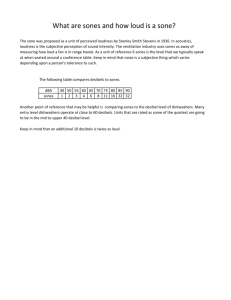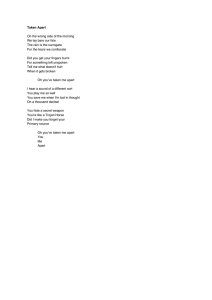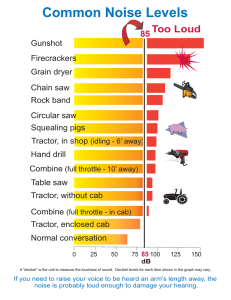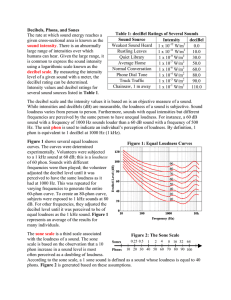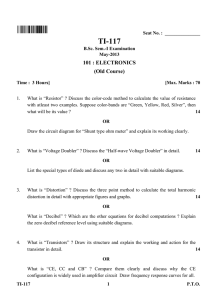What is a decibel?
advertisement
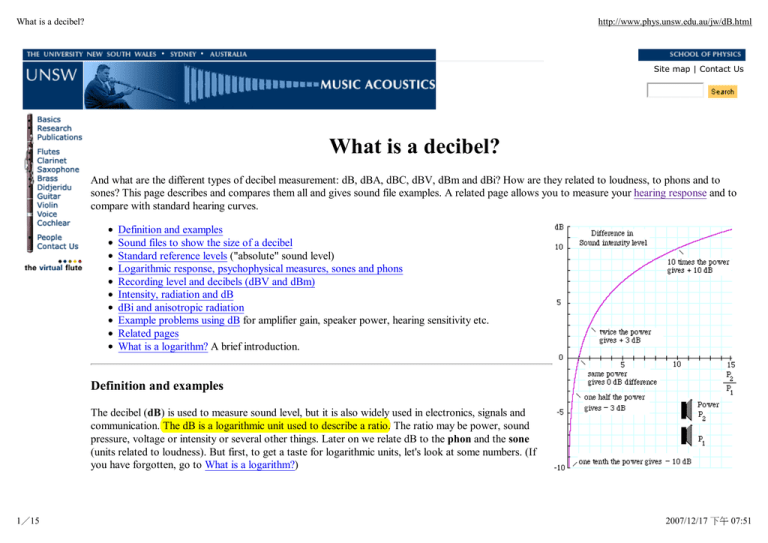
What is a decibel?
http://www.phys.unsw.edu.au/jw/dB.html
Site map | Contact Us
What is a decibel?
And what are the different types of decibel measurement: dB, dBA, dBC, dBV, dBm and dBi? How are they related to loudness, to phons and to
sones? This page describes and compares them all and gives sound file examples. A related page allows you to measure your hearing response and to
compare with standard hearing curves.
Definition and examples
Sound files to show the size of a decibel
Standard reference levels ("absolute" sound level)
Logarithmic response, psychophysical measures, sones and phons
Recording level and decibels (dBV and dBm)
Intensity, radiation and dB
dBi and anisotropic radiation
Example problems using dB for amplifier gain, speaker power, hearing sensitivity etc.
Related pages
What is a logarithm? A brief introduction.
Definition and examples
The decibel (dB) is used to measure sound level, but it is also widely used in electronics, signals and
communication. The dB is a logarithmic unit used to describe a ratio. The ratio may be power, sound
pressure, voltage or intensity or several other things. Later on we relate dB to the phon and the sone
(units related to loudness). But first, to get a taste for logarithmic units, let's look at some numbers. (If
you have forgotten, go to What is a logarithm?)
1/15
2007/12/17 下午 07:51
What is a decibel?
http://www.phys.unsw.edu.au/jw/dB.html
Plot of 10 log (P2/P1)
For instance, suppose we have two loudspeakers, the first playing a sound with power P1, and another
playing a louder version of the same sound with power P2, but everything else (how far away, frequency)
kept the same.
The difference in decibels between the two is defined to be
10 log (P2/P1) dB
where the log is to base 10.
If the second produces twice as much power than the first, the difference in dB is
10 log (P2/P1) = 10 log 2 = 3 dB.
If the second had 10 times the power of the first, the difference in dB would be
10 log (P2/P1)= 10 log 10 = 10 dB.
If the second had a million times the power of the first, the difference in dB would be
10 log (P2/P1) = 10 log 1000000 = 60 dB.
This example shows one feature of decibel scales that is useful in discussing sound: they can describe very
big ratios using numbers of modest size. But note that the decibel describes a ratio: so far we have not
said what power either of the speakers radiates, only the ratio of powers. (Note also the factor 10 in the
definition, which puts the 'deci' in decibel).
Sound pressure, sound level and dB. Sound is usually measured with microphones and they respond (approximately) proportionally to the sound pressure, p. Now
the power in a sound wave, all else equal, goes as the square of the pressure. (Similarly, electrical power in a resistor goes as the square of the voltage.) The log of
the square of x is just 2 log x, so this introduces a factor of 2 when we convert to decibels for pressures. The difference in sound pressure level between two sounds
with p1 and p2 is therefore:
20 log (p2/p1) dB = 10 log (p22/p12) dB = 10 log (P2/P1) dB
2/15
where again the log is to base 10.
2007/12/17 下午 07:51
What is a decibel?
http://www.phys.unsw.edu.au/jw/dB.html
Sound files to show the size of a decibel
What happens when you halve the sound power? The log of 2 is 0.3, so the log of 1/2 is −0.3. So, if you halve the power, you reduce the power and the sound level
by 3 dB. Halve it again (down to 1/4 of the original power) and you reduce the level by another 3 dB. That is exactly what we have done in the first graphic and
sound file below.
The first sample of sound is white noise (a mix of all audible frequencies, just as
white light is a mix of all visible frequencies). The second sample is the same
noise, with the voltage reduced by a factor of the square root of 2. The reciprocal
of the square root of 2 is approximately 0.7, so −3 dB corresponds to reducing the
voltage or the pressure to 70% of its original value. The green line shows the
voltage as a function of time. The red line shows a continuous exponential decay
with time. Note that the voltage falls by 50% for every second sample.
Note, too, that a doubling of the power does not make a huge difference to the
loudness. We'll discuss this further below, but it's a useful thing to remember when
choosing sound reproduction equipment.
Sound files and flash animation by John Tann and George Hatsidimitris.
If this animation doesn't work, or if you want .wav files, go to No flash version
How big is a decibel? In the next series, successive samples are reduced by just one decibel.
3/15
2007/12/17 下午 07:51
What is a decibel?
http://www.phys.unsw.edu.au/jw/dB.html
One decibel is close to the Just Noticeable Difference (JND) for sound level. As
you listen to these files, you will notice that the last is quieter than the first, but it
is rather less clear to the ear that the second of any pair is quieter than its
predecessor. 10*log10(1.26) = 1, so to increase the sound level by 1 dB, the
power must be increased by 26%, or the voltage by 12%.
What if the difference is less than a decibel? Sound levels are rarely given with decimal places. The reason is that sound levels that differ by less than 1 dB are hard
to distinguish, as the next example shows.
4/15
2007/12/17 下午 07:51
What is a decibel?
http://www.phys.unsw.edu.au/jw/dB.html
You may notice that the last is quieter than the first, but it is difficult to notice the
difference between successive pairs. 10*log10(1.07) = 0.3, so to increase the
sound level by 0.3 dB, the power must be increased by 7%, or the voltage by
3.5%.
Standard reference levels ("absolute" sound level)
When the decibel is used to give the sound level for a single sound rather than a ratio, then a reference level must be chosen. For sound intensity, the reference
level (for air) is usually chosen as 20 micropascals, or 0.02 mPa. (This is very low: it is 2 ten billionths of an atmosphere. Nevertheless, this is about the limit of
sensitivity of the human ear, in its most sensitive range of frequency. Usually this sensitivity is only found in rather young people or in people who have not
been exposed to loud music or other loud noises. Personal music systems with in-ear speakers ('walkmans') are capable of very high sound levels in the ear, and
are believed by some to be responsible for much of the hearing loss in young adults in developed countries.)
So if you read of a sound pressure level of 86 dB, it means that
20 log (p2/p1) = 86 dB
where p1 is the sound pressure of the reference level, and p2 that of the sound in question. Divide both sides by 20:
5/15
2007/12/17 下午 07:51
What is a decibel?
http://www.phys.unsw.edu.au/jw/dB.html
log (p2/p1) = 4.3
p2/p1 = 104.3
4 is the log of 10 thousand, 0.3 is the log of 2, so this sound has a sound pressure 20 thousand times greater than that of the reference level (p2/p1 = 20,000).
86 dB is a loud but not dangerous level of sound, if it is not maintained for very long.
What does 0 dB mean? This level occurs when the measured intensity is equal to the reference level. i.e., it is the sound level corresponding to 0.02 mPa. In
this case we have
sound level = 20 log (pmeasured/preference) = 20 log 1 = 0 dB
Remember that decibels measure a ratio. 0 dB occurs when you take the log of a ratio of 2. So 0 dB does not mean no sound, it means a sound level where the
sound pressure is equal to that of the reference level. This is a small pressure, but not zero. It is also possible to have negative sound levels: - 20 dB would
mean a sound with pressure 10 times smaller than the reference pressure, ie 2 micropascals.
Not all sound pressures are equally loud. This is because the human ear does not respond equally to all frequencies: we are much more sensitive to
sounds in the frequency range about 1 kHz to 4 kHz (1000 to 4000 vibrations per second) than to very low or high frequency sounds. For this reason, sound
meters are usually fitted with a filter whose response to frequency is a bit like that of the human ear. (More about these filters below.) If the "A weighting filter"
is used, the sound pressure level is given in units of dB(A) or dBA. Sound pressure level on the dBA scale is easy to measure and is therefore widely used. It is
still different from loudness, however, because the filter does not respond in quite the same way as the ear. To determine the loudness of a sound, one needs to
consult some curves representing the frequency response of the human ear, given below. (Alternatively, you can measure your own hearing response.)
Logarithmic response, psychophysical measures, sones and phons
Why do we use decibels? The ear is capable of hearing a very large range of sounds: the ratio of the sound pressure that causes permanent damage from short
exposure to the limit that (undamaged) ears can hear is more than a million. To deal with such a range, logarithmic units are useful: the log of a million is 6, so
this ratio represents a difference of 120 dB. Psychologists also say that our sense of hearing is roughly logarithmic (see under sones below). In other words,
they think that you have to increase the sound intensity by the same factor to have the same increase in loudness. Whether you agree or not is up to you,
because this is a rather subjective question. (Listen to the sound files linked above.)
The filters used for dBA and dBC
6/15
2007/12/17 下午 07:51
What is a decibel?
http://www.phys.unsw.edu.au/jw/dB.html
The most widely used sound level filter is the A scale, which roughly corresponds to the inverse of the 40 dB (at 1 kHz) equal-loudness curve. Using this filter,
the sound level meter is thus less sensitive to very high and very low frequencies. Measurements made on this scale are expressed as dBA. The C scale is
practically linear over several octaves and is thus suitable for subjective measurements only for very high sound levels. Measurements made on this scale are
expressed as dBC. There is also a (rarely used) B weighting scale, intermediate between A and C. The figure below shows the response of the A filter (left) and
C filter, with gains in dB given with respect to 1 kHz. (For an introduction to filters, see RC filters, integrators and differentiators.)
On the music acoustics and speech acoustics sites, we plot the sound spectra in dB. The reason for this common practice is that the range of measured sound
pressures is large.
Loudness, phons and sones
The phon is a unit that is related to dB by the psychophysically measured frequency response of the ear. At 1 kHz, readings in phons and dB are, by definition,
the same. For all other frequencies, the phon scale is determined by the results of experiments in which volunteers were asked to adjust the loudness of a signal
at a given frequency until they judged its loudness to equal that of a 1 kHz signal. To convert from dB to phons, you need a graph of such results. Such a graph
depends on sound level: it becomes flatter at high sound levels.
7/15
2007/12/17 下午 07:51
What is a decibel?
http://www.phys.unsw.edu.au/jw/dB.html
Curves of equal loudness determined experimentally by Robinson & Dadson in 1956, following the original work of Fletcher & Munson (Fletcher, H. and Munson, W.A. (1933)
J.Acoust.Soc.Am. 6:59; Robinson, D.W. and Dadson, R.S.(1956) Br. J. Appl. Phys. 7:166. Plots of equal loudness as a function of frequency are often generically called
Fletcher-Munson curves.)
The sone is derived from psychophysical measurements which involved volunteers adjusting sounds until they judge them to be twice as loud. This allows one
to relate perceived loudness to phons. A sone is defined to be equal to 40 phons. Experimentally it was found that a 10 dB increase in sound level
corresponds approximately to a perceived doubling of loudness. So that approximation is used in the definition of the phon: 0.5 sone = 30 phon, 1 sone =
40 phon, 2 sone = 50 phon, 4 sone = 60 phon, etc.
Wouldn't it be great to be able to convert from dB (which can be measured by an instrument) to sones (which approximate loudness as perceived by people)?
This is usually done using tables that you can find in acoustics handbooks. However, if you don't mind a rather crude approximation, you can say that the A
weighting curve approximates the human frequency response at low to moderate sound levels, so dBA is very roughly the same as phons. Then use the
8/15
2007/12/17 下午 07:51
What is a decibel?
http://www.phys.unsw.edu.au/jw/dB.html
logarithmic relation between sones and phons described above.
Recording level and decibels
Meters measuring recording or output level on audio electronic gear (mixing consoles etc) are almost always recording the AC rms voltage (see links to find
out about AC and rms). For a given resistor R, the power P is V2/R, so
difference in voltage level = 20 log (V2/V1) dB = 10 log (V22/V12) dB = 10 log (P2/P1) dB,
or
absolute voltage level = 20 log (V/Vref)
where Vref is a reference voltage. So what is the reference voltage?
The obvious level to choose is one volt rms, and in this case the level is written as dBV. This is rational, and also convenient with modern analog-digital cards
whose maximum range is often about one volt rms. So one has to remember to the keep the level in negative dBV (less than one volt) to avoid clipping the
peaks of the signal, but not too negative (so your signal is still much bigger than the background noise).
Sometimes you will see dBm. This used to mean decibels of electrical power, with respect to one milliwatt, and sometimes it still does. However, it's
complicated for historical reasons. In the mid twentieth century, many audio lines had a nominal impedance of 600 Ω. If the impedance is purely resisitive, and
if you set V2/600 Ω = 1 mW, then you get V = 0.775 volts. So, providing you were using a 600 Ω load, 1 mW of power was 0 dBm was 0.775 V, and so you
calibrated your level meters thus. The problem arose because, once a level meter that measures voltage is calibrated like this, it will read 0 dBm at 0.775 V even
if it is not connected to 600 Ω So, perhaps illogically, dBm will sometimes mean dB with respect to 0.775 V. (When I was a boy, calculators were expensive so I used
dad's old slide rule, which had the factor 0.775 marked on the cursor window to facilitate such calculations.)
How to convert dBV or dBm into dB of sound level? There is no simple way. It depends on how you convert the electrical power into sound power. Even if
your electrical signal is connected directly to a loudspeaker, the conversion will depend on the efficiency and impedance of your loudspeaker. And of course
there may be a power amplifier, and various acoustic complications between where you measure the dBV on the mixing desk and where your ears are in the
sound field.
Intensity, radiation and dB
How does sound level (or radio signal level, etc) depend on distance from the source?
9/15
2007/12/17 下午 07:51
What is a decibel?
http://www.phys.unsw.edu.au/jw/dB.html
A source tht emits radiation equally in all directions is called isotropic. Consider an isolated source of sound, far from any
reflecting surfaces -- perhaps a bird singing high in the air. Imagine a sphere with radius r, centred on the source. The
source outputs a total power P, continuously. This sound power spreads out and is passing through the surface of the
sphere. If the source is isotropic, the intensity I is the same everywhere on this surface, by definition. The intensity I is
defined as the power per unit area. The surface area of the sphere is 4 πr2, so the power (in our example, the sound
power) passing through each square metre of surface is, by definition:
I = P/4 πr2.
So we see that, for an isotropic source, intensity is inversely proportional to the square of the distance away from the
source:
I2/I1 = r12/r22.
But intensity is proportional to the square of the sound pressure, so we could equally write:
p2/p1 = r1/r2.
So, if we double the distance, we reduce the sound pressure by a factor of 2 and the intensity by a factor of 4: in other words, we reduce the sound level by 6
dB. If we increase r by a factor of 10, we decrease the level by 20 dB, etc.
Be warned, however, that many sources are not isotropic, especially if the wavelength is smaller than, or of a size comparable with the source. Further,
reflections are often quite important, especially if the ground is nearby, or if you are indoors.
dBi and radiation that varies with direction
Radiation that varies in direction is called anisotropic. For many cases in communication, isotropic radiation is wasteful: why emit a substantial fraction of
power upwards if the receiver is, like you, relatively close to ground level. For sound of short wavelength (including most of the important range for speech), a
megaphone can help make your voice more anisotropic. For radio, a wide range of designs allows antennae to be highly anisotropic for both transmission and
reception.
So, when you interested in emission in (or reception from) a particular direction, you want the ratio of intensity measured in that direction, at a given distance,
to be higher than that measured at the same distance from an isotropic radiator (or received by an isotropic receiver). This ratio is called the gain; express the
ratio in dB and you have the gain in dBi for that radiator. This unit is mainly used for antennae, either transmitting and receiving, but it is sometimes used for
sound sources (and directional microphones).
Example problems
10/15
2007/12/17 下午 07:51
What is a decibel?
http://www.phys.unsw.edu.au/jw/dB.html
A few people have written asking for examples in using dB in calculations. So...
All else equal, how much louder is loudspeaker driven (in its linear range) by a 100 W amplifier than by a 10 W amplifier?
The powers differ by a factor of ten, which, as we saw above, is 10 dB. All else equal here means that the frequency responses are equal and that the same input
signal is used, etc. So the frequency dependence should be the same. 10 dB corresponds to 10 phons. To get a perceived doubling of loudness, you need an
increase of 10 phons. So the speaker driven by the 100 W amplifier is twice as loud as when driven by the 10 W, assuming you stay in the linear range and don't
distort or destroy the speaker. (The 100 W amplifier produces twice as many sones as does the 10 W.)
I am standing at a distance R from a small source of sound (size much less than R), at ground level out in the open where reflections may be neglected. The
sound level is L. If I now move to a distance nR (n a number, and nR still much greater than the size of the source), what will be the new sound level?
First, note that the neglect of reflections is very important. This calculation will not work inside a room, where reflections from the wall (collectively producing
reverberation) make the calculation quite difficult. Out in the open, the sound intensity is proportional to 1/r2, where r is the distance from the source. (The
constant of proportionality depends on how well the ground reflects, and doesn't concern us here, because it will cancel in the calculation.) So, if we increase r
from R to nR, we decrease the intensity from I to I/n 2.
The difference in decibels between the two signals of intensity I 2 and I 1 is defined above to be
ΔL = 10 log (I2/I1) = 10 log ((I/n 2)/I) = 10 log (1/n 2) = −10 log (n 2) = −20 log n.
For example, if n is 2 (ie if we go twice as far away), the intensity is reduced by a factor of four and sound level falls from L to (L − 6dB).
If, in ideal quiet conditions, a young person can hear a 1 kHz tone at 0 dB emitted by a loudspeaker (perhaps a softspeaker?), by how much must the power of
the loudspeaker be increased to raise the sound to 110 dB (a dangerously loud but survivable level)?
The difference in decibels between the two signals of power P2 and P1 is defined above to be
ΔL = 10 log (P2/P1) dB so, raising 10 to the power of these two equal quantities:
10L/10 = P2/P1 so:
P2/P1 = 10110/10 = 1011 = one hundred thousand million.
which is a demonstration that the human ear has a remarkably large dynamic range, perhaps 100 times greater than that of the eye.
11/15
2007/12/17 下午 07:51
What is a decibel?
http://www.phys.unsw.edu.au/jw/dB.html
An amplifier has an input of 10 mV and and output of 2 V. What is its voltage gain in dB?
Voltage, like pressure, appears squared in expressions for power or intensity. (The power dissipated in a resistor R is V2/R.) So, by convention, we define:
gain = 20 log (Vout/Vin)
= 20 log (2V/10mV)
= 46 dB
(In the acoustic cases given above, we saw that the pressure ratio, expressed in dB, was the same as the power ratio: that was the reason for the factor 20 when defining dB for
pressure. It is worth noting that, in the voltage gain example, the power gain of the ampifier is unlikely to equal the voltage gain. The power is proportional to the square of the voltage
in a given resistor. However, the input and output impedances of amplifiers are often quite different. For instance, a buffer amplifier or emitter follower has a voltage gain of about 1,
but a large current gain.)
A FAQ
A few people have written asking for examples of sounds in dB or dBA. How loud is an aircraft? A train? A person singing? A dog barking? A power tool?
The answers to this question vary considerably. It depends strongly upon how far away you are, whether you are indoors or not, whether there is reverberation,
how strong the particular source is and what its spectrum is. To give values, without being very specific about the conditions, would be somewhat misleading.
Because the rest of this page is intended to be reliable, as far as it goes, I'd rather not give values here.
Related pages
Measure your own hearing response
What are interference beats and Tartini tones?
FAQ in music acoustics
Loudness and spectra: how spectral content and other features are related to loudness
Music acoustics home page
Physclips: a multi-level, multimedia introduction to mechanics.
A list of other educational web sites from this author.
© 1998. JoeWolfe Modified 15/9/06
[Basics | Research | Publications | Flutes | Clarinet | Saxophone | Brass | Didjeridu | Guitar | Violin | Voice | Cochlear ]
12/15
2007/12/17 下午 07:51
What is a decibel?
http://www.phys.unsw.edu.au/jw/dB.html
[ People | Contact Us | Home ]
© Joe Wolfe / J.Wolfe@unsw.edu.au
phone 61-2-9385 4954 (UT + 10, +11 Oct-Mar)
Joe's music site
What is a logarithm? A brief introduction.
First let's look at exponents. If we write 102 or 103 , we mean
102 = 10*10 = 100 and 103 = 10*10*10 = 1000.
So the exponent (2 or 3 in our example) tells us how many times to multiply the base (10 in our example) by itself. For this page, we only need logarithms to
base 10, so that's all we'll discuss. In these examples, 2 is the log of 100, and 3 is the log of 1000. If we multiply ten by itself only once, we get 10, so 1 is the
log of 10, or in other words
101 = 10.
We can also have negative logarithms. When we write 10−2 we mean 0.01, which is 1/100, so
10−n = 1/10n
Let's go one step more complicated. Let's work out the value of (102)3. This is easy enough to do, one step at a time:
(102)3 = (100)3 = 100*100*100 = 1,000,000 = 106.
By writing it out, you should convince yourself that, for any whole numbers n and m,
(10n)m = 10nm.
13/15
2007/12/17 下午 07:51
What is a decibel?
http://www.phys.unsw.edu.au/jw/dB.html
But what if n is not a whole number? Since the rules we have used so far don't tell us what this
would mean, we can define it to mean what we like, but we should choose our definition so that it is
consistent. The definition of the logarithm of a number a (to base 10) is this:
10log a = a.
In other words, the log of the number a is the power to which you must raise 10 to get the
number a. For an example of a number whose log is not a whole number, let's consider the square
root of 10, which is 3.1623..., in other words 3.16232 = 10. Using our definition above, we can
write this as
3.16232 = (10log 3.1623)2 = 10 = 101.
However, using our rule that (10n)m = 10nm, we see that in this case log 3.1623*2 = 1, so the log of
3.1623... is 1/2. The square root of 10 is 100.5. Now there are a couple of questions: how do we
calculate logs? and Can we be sure that all real numbers greater than zero have real logs? We leave
these to mathematicians (who, by the way, would be happy to give you a more rigorous treatment
of exponents that this superficial account).
A few other important examples are worth noting. 100 would have the property that, no matter how
many times you multiplied it by itself, it would never get as large as 10. Further, no matter how
many times you divided it into 1, you would never get as small as 1/10. Using our (10n)m = 10nm
rule, you will see that 100 = 1 satisfies this, so the log of one is zero. The log of 2 is used often in
acoustics, and it is 0.3010 (see graph at right). Hence, a factor of 2 in power corresponds to
3.01 dB, which we should normally write as 3 dB because, as you can discover for yourself in
hearing response, decimal points of decibels are usually too small to notice.
log10x vs x.
Go back to top of page.
© Joe Wolfe / J.Wolfe@unsw.edu.au.
Happy birthday, theory of relativity!
As of June 2005, relativity is 100 years old. Our contribution is
Einstein Light: relativity in brief... or in detail. It explains the key
14/15
2007/12/17 下午 07:51
What is a decibel?
http://www.phys.unsw.edu.au/jw/dB.html
ideas in a short multimedia presentation, which is supported by
links to broader and deeper explanations.
15/15
2007/12/17 下午 07:51

